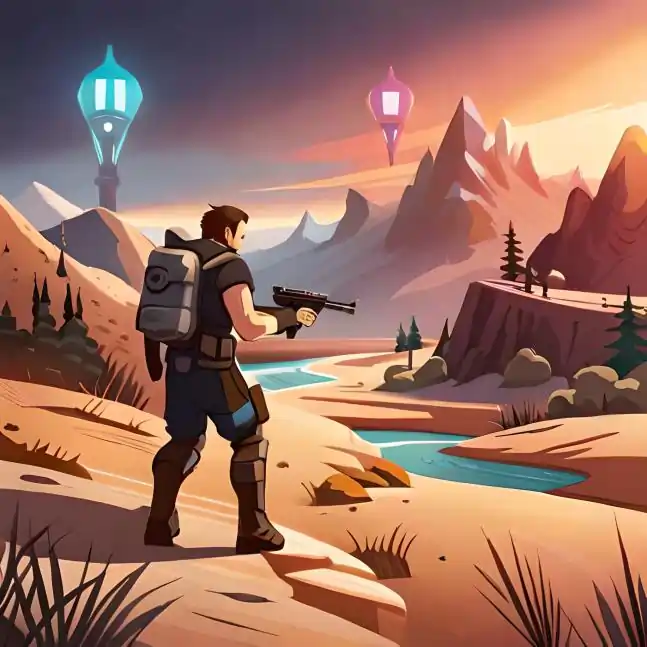Unleashing the Power of Unity 3D: Take Your Best Gaming Experience to the Next Level!

Introduction
The increasing popularity of Unity 3D in the gaming industry
In recent years, the gaming industry has witnessed a meteoric rise in the popularity of Unity 3D. This powerful game development platform has become the go-to choice for developers who seek to create cutting-edge and immersive gaming experiences. With its extensive set of features and tools Unity 3D has revolutionized the way games are designed developed and played.
Exploring the potential of Unity 3D for enhanced gaming experiences
Unity 3D offers unparalleled potential for taking gaming experiences to the next level. Whether you’re a developer looking to create visually stunning environments implement realistic physics and gameplay mechanics or enhance audio design for an immersive experience Unity 3D provides the tools and capabilities to turn your vision into reality. In this article, we will delve into the various aspects of Unity 3D and uncover the secret behind its immense power in the gaming realm.
Understanding Unity 3D
A. What is Unity 3D?
Introduction to Unity 3D game engine and its capabilities
Unity 3D is a powerful and versatile game engine that allows developers to create high-quality games for multiple platforms. It provides a comprehensive suite of tools and features that streamline the game development process making it accessible even for beginners. From graphics and physics simulation to audio design and scripting Unity 3D empowers developers to bring their creative ideas to life.

B. Unity 3D Features and Tools
Graphics and rendering capabilities
One of Unity 3D’s standout features is its advanced graphics and rendering capabilities. With support for modern rendering techniques such as physically-based shading and global illumination developers can create visually stunning and realistic environments. Unity 3D also provides a wide range of effects, such as bloom depth of field and motion blur allowing for the creation of visually captivating scenes.
Physics simulation and gameplay mechanics
Unity 3D includes a robust physics engine that enables developers to accurately simulate real-world physics in their games. This allows for the creation of lifelike interactions between objects such as realistic collisions , gravity and complex movements. Coupled with Unity’s powerful scripting capabilities developers can implement intricate gameplay mechanics that offer engaging and dynamic experiences for players.
Audio systems and immersive sound design
Sound is an essential element in creating immersive gaming experiences, and Unity 3D offers a comprehensive audio system to fulfill this requirement. From creating realistic soundscapes to synchronizing audio with gameplay events, Unity 3D allows developers to design rich and dynamic audio that enhances the overall immersion of the game.
Scripting and coding possibilities
Unity 3D supports multiple scripting languages, including C# and UnityScript (a variant of JavaScript), giving developers the flexibility to write code in their preferred language. This opens up a world of possibilities for implementing complex game logic, artificial intelligence, and interactive elements, ultimately resulting in richer and more interactive gameplay experiences.
Asset management and importing
Unity 3D provides an intuitive asset management system that allows developers to import and organize game assets efficiently. From 3D models and textures to audio files and animations, Unity 3D simplifies the process of managing assets, ensuring seamless integration into the game development workflow.
C. Benefits of Unity 3D
Advantages for developers and gamers alike
Unity 3D offers a myriad of benefits for both developers and gamers. For developers, it provides an intuitive and user-friendly environment that simplifies the game development process, allowing for rapid prototyping and iteration. Additionally, Unity 3D supports cross-platform development, enabling developers to create games for various platforms, including PC, consoles, mobile devices, and even virtual reality (VR) headsets.
For gamers, Unity 3D ensures a consistent and enjoyable gaming experience across different platforms. With its cross-platform compatibility, players can seamlessly play Unity 3D games on their preferred devices, allowing for wider accessibility and reach. This convenience makes Unity 3D a preferred choice for both developers and gamers in the ever-expanding world of gaming.
Enhancing Visuals with Unity 3D
A. Graphical Rendering in Unity 3D
Understanding shaders and materials
Shaders and materials play a crucial role in creating visually appealing graphics in Unity 3D. Shaders define how objects are rendered, determining the lighting, surface properties, and visual effects. Materials, on the other hand, define the appearance of objects by specifying textures, colors, and transparency. By mastering the use of shaders and materials, developers can achieve stunning visuals that enhance the overall aesthetics of their games.
Realistic lighting and shadows
One of the key factors in creating realistic visuals in Unity 3D is the implementation of advanced lighting and shadow techniques. Unity 3D supports various lighting models, including real-time global illumination, which dynamically simulates realistic lighting conditions. Developers can also incorporate dynamic shadows to add depth and realism to their scenes, elevating the visual quality to new heights.
Post-processing effects for stunning visuals
Unity 3D offers a wide range of post-processing effects that can be used to enhance the visual fidelity of games. These effects include bloom, depth of field, motion blur, color grading, and many more. By applying these effects selectively, developers can achieve cinematic visuals that captivate players and elevate the overall gaming experience.
B. Creating Virtual Environments
Building realistic landscapes and terrains
Unity 3D provides powerful tools for creating realistic virtual landscapes and terrains. Developers can sculpt terrains, paint textures, and add vegetation to bring their virtual worlds to life. With the ability to generate vast and intricate environments, Unity 3D empowers developers to create immersive and visually stunning game worlds.
Integrating 3D models and animations
To populate their virtual environments, developers can import 3D models and animations into Unity 3D. This allows for the creation of diverse and interactive game assets, ranging from characters and creatures to vehicles and props. By leveraging Unity’s animation system, developers can bring these assets to life, enabling captivating and lifelike interactions within the game.
Implementing particle systems for immersive experiences
Particle systems are essential for creating immersive experiences in Unity 3D. Whether it’s simulating realistic fire, water, smoke, or magical effects, Unity 3D’s particle system enables developers to add visual flair and dynamism to their games. By utilizing particle systems, developers can create breathtaking moments that leave a lasting impression on players.
C. User Interface (UI) Design in Unity 3D
Designing user-friendly menus and interfaces
A well-designed user interface (UI) is crucial for providing players with an intuitive and seamless gaming experience. Unity 3D offers a flexible UI system that allows developers to design user-friendly menus and interfaces. From buttons and sliders to panels and scroll views, developers can create visually appealing and interactive UI elements that enhance usability and player engagement.
Implementing responsive UI elements
In today’s ever-evolving gaming landscape, responsive UI elements have become integral to providing a smooth and immersive user experience. Unity 3D encompasses tools and features that enable developers to implement responsive UI elements that adapt to different screen sizes and input devices. This ensures that players can enjoy the game seamlessly across various platforms and devices.
Enhancing interactivity and user experience
Unity 3D provides a wide array of tools and APIs that allow developers to enhance interactivity and improve the overall user experience. By utilizing features such as physics-based interactions, touch gestures, and animations, developers can create engaging and immersive gameplay moments that captivate players. With Unity 3D’s user-centric approach, developers can focus on crafting unforgettable gaming experiences that keep players coming back for more.






Harnessing Unity 3D for Gameplay Mechanics
A. Physics and Collision Systems
Utilizing Unity’s built-in physics engine
Unity 3D’s built-in physics engine provides developers with a powerful toolset for simulating realistic physics in their games. Whether it’s calculating object movements, handling collisions, or applying forces, Unity’s physics engine ensures accurate simulations that enhance the immersion and believability of the game world. By harnessing these physics capabilities, developers can create unique and interactive gameplay experiences.
Simulating realistic collisions and interactions
In Unity 3D, developers can configure colliders on game objects to enable accurate collision detection. This allows for the creation of realistic interactions between objects, such as objects bouncing off each other or triggering specific events upon collision. By carefully tuning these collision systems, developers can introduce exciting and dynamic gameplay mechanics that add depth and realism to their games.
Creating platforms and vehicles with physics
Unity 3D’s physics engine also enables the creation of dynamic platforms and vehicles within games. By applying forces and constraints to objects, developers can simulate realistic movements and behaviors for platforms and vehicles. This opens up possibilities for creating challenging platforming levels, exhilarating vehicle-based gameplay, and much more.
B. Artificial Intelligence (AI) in Unity 3D
Implementing AI behaviors and decision-making
Artificial Intelligence (AI) plays a crucial role in creating engaging and challenging gameplay experiences. Unity 3D provides developers with a range of AI tools and APIs that empower them to create intelligent behaviors and decision-making systems for in-game characters. By implementing AI in their games, developers can introduce dynamic and responsive NPC behaviors that adapt to player actions, enhancing the overall immersion and depth of the game world.
Designing intelligent NPCs and enemies
In Unity 3D, developers can design intelligent non-player characters (NPCs) and enemies with sophisticated AI capabilities. These AI-driven characters can exhibit lifelike behaviors, such as pathfinding, decision-making, and interaction with their surroundings. By creating intelligent NPCs and enemies, developers can challenge and entertain players with thrilling and unpredictable gameplay scenarios.
Creating dynamic game experiences with AI
With Unity 3D’s AI capabilities, developers can create games that offer dynamic and ever-changing experiences. By leveraging AI algorithms and scripting, developers can introduce elements such as procedural generation, dynamic difficulty adjustment, and adaptive gameplay. This ensures that every playthrough is unique and tailored to each player, enhancing replayability and keeping players engaged for hours on end.
C. Multiplayer and Networking Capabilities
Integrating multiplayer functionality in Unity 3D
Unity 3D provides powerful networking features that enable developers to create multiplayer games with ease. With Unity’s high-level networking APIs and pre-built components, developers can seamlessly integrate multiplayer functionality into their games. This allows for real-time multiplayer experiences, where players can compete or cooperate with each other, fostering social interactions and creating engaging and dynamic gameplay scenarios.
Real-time networked gameplay experiences
Unity 3D’s networking capabilities enable real-time interactions between players, regardless of their geographical locations. With support for low-latency network synchronization and authoritative server architecture, Unity 3D ensures smooth and seamless multiplayer experiences. Whether it’s battling friends in an intense online shooter or collaborating with teammates in a cooperative adventure, Unity 3D’s networking capabilities elevate the multiplayer experience to new heights.
Managing player interactions and online communities
Unity 3D provides tools and features for managing player interactions and fostering online communities. From matchmaking and leaderboards to in-game chat systems, developers can create social experiences that connect players and encourage friendly competition. With Unity 3D, developers can build vibrant and thriving online communities around their games, keeping players engaged and invested in the gaming experience.
Immersive Audio Design with Unity 3D
A. Implementing Audio in Unity 3D
Understanding audio sources and listeners
Audio is a vital component in creating immersive gaming experiences, and Unity 3D offers a comprehensive audio system to support developers in this endeavor. Unity 3D includes audio sources, which emit sound within the game world, and audio listeners, which capture and process audio for the player. By manipulating audio sources and listeners, developers can achieve realistic and spatial audio effects that enhance the overall immersion of the game.
Creating realistic soundscapes and effects
Unity 3D allows developers to create rich and realistic soundscapes by incorporating a variety of audio effects. From environmental ambience and character vocals to weapon sounds and explosions, Unity 3D enables developers to design audio that evokes specific moods and enhances the overall atmosphere of the game. With the ability to mix, blend, and spatialize audio, Unity 3D empowers developers to create soundscapes that pull players deeper into the game world.
Syncing audio with gameplay events
Unity 3D provides tools and features that enable developers to synchronize audio with gameplay events. Whether it’s triggering sound effects upon a character’s action or creating dramatic music cues during key moments, Unity 3D’s audio system offers precise control over audio playback. By aligning audio with gameplay events, developers can create immersive and dynamic audio experiences that heighten the overall impact of the game.
B. Spatial Audio and 3D Sound
Enhanced immersion through spatial audio
Spatial audio plays a crucial role in creating a sense of presence and immersion in virtual environments. Unity 3D offers spatial audio capabilities that allow developers to place sound sources in three-dimensional space. With the use of advanced algorithms and audio panning techniques, Unity 3D provides players with a realistic and immersive audio experience, where sound behaves as it would in the real world. From footsteps echoing in a cave to distant explosions, spatial audio in Unity 3D enhances the realism and immersion of the game world.
Positional sound effects and ambience
In Unity 3D, developers can apply positional sound effects and ambience to further enhance the immersive experience. By assigning specific positions and audio settings to sound sources, developers can create a dynamic audio environment that reacts and changes based on the player’s position and actions. This attention to detail adds depth and realism to the game world, ensuring that players are fully immersed in the audio experience.
Dynamic audio in virtual reality (VR) experiences
Unity 3D’s audio capabilities extend to virtual reality (VR) experiences, where audio plays a crucial role in creating a sense of presence and immersion. In VR, accurate and responsive audio cues are essential for simulating a believable and immersive environment. Unity 3D provides developers with tools and features to create audio experiences that seamlessly integrate with the immersive visuals of VR, further enriching the sense of immersion and realism.
Performance Optimization and Deployment
A. Optimizing Unity 3D Projects
Reducing memory usage and improving performance
Optimizing performance is crucial to ensuring that Unity 3D projects run smoothly and efficiently. Unity 3D provides various optimization techniques to reduce memory usage and improve overall performance. From efficient asset management to optimizing scripts and graphics, developers can employ pro tips and best practices to create optimized games that deliver a seamless and engaging experience.
Efficient asset management and organization
Unity 3D offers a robust asset management system that allows developers to organize and optimize game assets efficiently. By employing strategies such as asset bundling, texture compression, and level-of-detail (LOD) systems, developers can effectively reduce memory usage while maintaining visual quality. Additionally, Unity 3D provides features like asset streaming and asset serialization to further optimize project performance.
Pro tips for optimizing graphics and scripts
When it comes to optimizing graphics and scripts in Unity 3D, developers can benefit from various techniques and best practices. From using optimized shaders and GPU instancing to reducing draw calls and optimizing script execution, Unity 3D provides a range of tools and resources to help developers achieve optimal performance. By following these pro tips, developers can ensure that their games run smoothly across different platforms and devices.
B. Platforms and Distribution
Deployment options for different platforms
Unity 3D offers extensive deployment options for various platforms, allowing developers to reach a wide audience with their games. Whether it’s PC, Mac, consoles, mobile devices, or even web platforms, Unity 3D provides the tools and frameworks to effortlessly deploy games across multiple platforms. This versatility enables developers to maximize the reach of their games and cater to diverse.
Unity 3D, a powerful game development engine, offers a variety of deployment options for different platforms. Whether you aim to captivate gamers on desktop, mobile, or even virtual reality devices, Unity 3D provides the tools to make it happen. With just a few clicks, you can effortlessly publish and market your Unity 3D game, allowing you to reach wider audiences and maximize your game’s potential. Let’s dive into the world of platforms and distribution in Unity 3D.
Deployment options for different platforms
Unity 3D supports a wide range of platforms, including Windows, macOS, Linux, iOS, Android, WebGL, PlayStation, Xbox, and more. Its cross-platform capabilities eliminate the need for developers to write separate code for each platform, saving time and effort.Whether you want to create a mobile game for iOS and Android or a desktop game for Windows and macOS, Unity 3D has got you covered.
Publishing and marketing your Unity 3D game
Once your Unity 3D game is ready, you can choose from various publishing options to share your creation with the world. Unity allows you to publish your game on app stores like Apple App Store and Google Play Store, making it accessible to millions of potential players. Additionally, you can leverage web platforms like Steam or your own website to distribute and sell your game directly. It’s crucial to have a well-planned marketing strategy to ensure your game gets noticed in the saturated gaming market. Spread the word through social media, influencer collaborations, and targeted advertising.
Reaching wider audiences through app stores and web platforms
- Publishing your game on app stores ensures exposure to a massive user base. It allows players to discover your game organically through app store search and recommendations.
- On the other hand, web platforms provide flexibility and freedom in terms of distribution and monetization. You can offer your game for free, use subscription models, or sell it directly to your audience.
- By utilizing both app stores and web platforms, you can tap into diverse audiences, maximizing the reach and potential revenue of your Unity 3D game.
Certainly, here’s a table outlining the pros and cons of the title “Unleashing the Power of Unity 3D: Take Your Gaming Experience to the Next Level!”:
| Pros | Cons |
|---|---|
| 1. Engaging and Exciting: The title is attention-grabbing and suggests an exciting journey into the world of game development. | 1. Long and Complex: The title is quite lengthy, which may make it less memorable and harder to fit in some contexts. |
| 2. Clearly Communicates Content: It clearly communicates that the content will focus on Unity 3D and enhancing gaming experiences. | 2. May Overpromise: The title implies that the reader will be able to take their gaming experience to the “next level,” which may set unrealistic expectations. |
| 3. Appeals to Gamers and Developers: It targets both gamers looking to enhance their gaming experiences and game developers interested in using Unity 3D. | 3. Lack of Specifics: It doesn’t provide specific details about what the content will cover, leaving some uncertainty. |
| 4. Implies Empowerment: The phrase “Unleashing the Power” suggests that readers will gain knowledge and skills to create powerful games. | 4. Generic Phrasing: The phrase “Take Your Gaming Experience to the Next Level” is somewhat overused in the industry and lacks uniqueness. |
Overall, while the title is attention-grabbing and communicates the general focus of the content, it may benefit from being more concise and providing specific details about what readers can expect to learn or achieve. Additionally, it’s important to manage expectations to ensure readers aren’t disappointed if the content doesn’t radically transform their gaming experiences.
Summary
In summary, Unity 3D empowers game developers to revolutionize gaming experiences. Its seamless integration with various platforms opens up a world of possibilities, enabling you to create immersive games that captivate audiences across different devices. By effectively utilizing publishing options and marketing strategies, you can gain a larger share of the gaming market and maximize the success of your Unity 3D game.
Starting your journey into Unity 3D game development is a thrilling step towards creative expression and innovation. The potential to create captivating games with Unity 3D is limitless, and it’s time to unleash your creativity!
FAQs Here are some frequently asked questions about Unity 3D:
Can Unity 3D be used by beginners or is it better suited for experienced developers?
Unity 3D caters to both beginners and experienced developers. Its intuitive interface and extensive documentation make it beginner-friendly, while its powerful features and flexibility cater to the needs of experienced developers.
Is Unity 3D capable of handling large and complex games?
Absolutely! Unity 3D has been used to create some of the most expansive and complex games in the industry. Its scalability and optimization options make it suitable for projects of any size and scope.
Can Unity 3D games be played across different platforms?
Yes, Unity 3D allows you to build games that can be played on multiple platforms seamlessly. Its cross-platform capabilities ensure that players on various devices can enjoy your game without compatibility issues.
Are there any limitations or drawbacks to using Unity 3D?
While Unity 3D is a powerful tool, like any software, it does come with certain limitations. These limitations primarily depend on the hardware and platforms you’re targeting. However, Unity’s continuous updates and active community often address these limitations and provide workarounds.
Are there online resources or communities for Unity 3D development?
Absolutely! Unity 3D has a vast and vibrant community of developers who are always willing to help and share their knowledge. Additionally, Unity provides extensive documentation, tutorials, and forums to assist developers at all skill levels.
Now that you have a deeper understanding of the power of Unity 3D and how it can revolutionize your gaming experiences, it’s time to dive into the world of Unity 3D game development. Embrace the opportunities it offers, and let your creativity soar to new heights!

